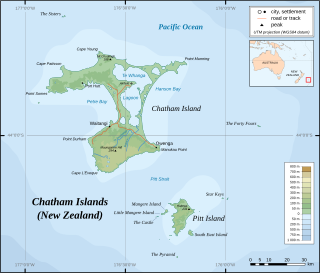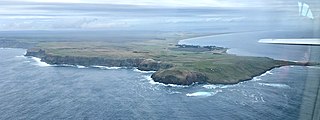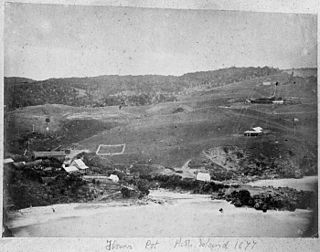
The Chatham Islands are an archipelago in the Pacific Ocean about 800 km (430 nmi) east of New Zealand's South Island, administered as part of New Zealand, and consisting of about 10 islands within an approximate 60 km (30 nmi) radius, the largest of which are Chatham Island and Pitt Island (Rangiauria). They include New Zealand's easternmost point, the Forty-Fours. Some of the islands, formerly cleared for farming, are now preserved as nature reserves to conserve some of the unique flora and fauna.

The Pyramid (Moriori: Tcharako; Māori: Te Tara Koi Koia; officially The Pyramid (Tarakoikoia)) is a small island south of Pitt Island in the Chatham Islands group of New Zealand. The site has been identified as an Important Bird Area by BirdLife International because it supports the only known breeding colony of Chatham albatrosses, with 4575 pairs recorded in 2001.

Tiwai Point lies at the entrance to Bluff Harbour on the southern coast of the South Island of New Zealand. A spit which extends from the western end of the Awarua Plain, it lies between Awarua Bay to the north and Foveaux Strait to the south. It is known for the Tiwai Point Aluminium Smelter, one of the largest industrial facilities in New Zealand.

The Bounty Islands are a small group of uninhabited granite islets and numerous rocks, with a combined area of circa 50 ha in the South Pacific Ocean. Territorially part of New Zealand, they lie about 670 km (420 mi) east-south-east of New Zealand's South Island, 530 km (330 mi) south-west of the Chatham Islands, and 215 km (134 mi) north of the Antipodes Islands. The group is a World Heritage Site.

Moturoa / Rabbit Island is a small island that lies across the southernmost part of Tasman Bay / Te Tai-o-Aorere, on the northern coast of New Zealand's South Island. The long narrow island runs east–west for 8 kilometres (5 mi), and covers 15 km2 (5.8 sq mi).

The Otago shag, together with the Foveaux shag formerly known as the Stewart Island shag and in its dark phase as the bronze shag, is a species of shag now found only in coastal Otago, New Zealand.

Mangere Island is part of the Chatham Islands archipelago, located about 800 kilometres (500 mi) east of New Zealand's South Island and has an area of 113 hectares. The island lies off the west coast of Pitt Island, 45 kilometres (28 mi) south-east of the main settlement in the Chathams, Waitangi, on Chatham Island.

Hokorereoro, Rangatira, or South East Island is the third largest island in the Chatham Islands archipelago, and covers an area of 218 hectares. It lies 800 kilometres (497 mi) east of New Zealand's South Island off the south-east coast of Pitt Island, 55 kilometres (34 mi) south-east of the main settlement, Waitangi, on Chatham Island.

The Sisters is a group of three main islands located 16 kilometres (10 mi) north of Cape Pattison, Chatham Island. They are the northernmost members of the Chatham Archipelago, located 800 kilometres (497 mi) east of New Zealand's South Island.

The Star Keys are group of five rocky islets in the Chatham Archipelago, about 12 kilometres (7 mi) east of Pitt Island. The archipelago is part of New Zealand, whose South Island lies 800 kilometres (497 mi) to the west.

The Chatham Islands parakeet, also known as Forbes' parakeet, is a rare parakeet endemic to the Chatham Islands group, New Zealand. This parakeet is one of New Zealand's rarest birds and is classified as Vulnerable on the IUCN Red List, as a result of a range of threats to the species survival, including habitat loss, predation, and hybridization. A number of conservation methods have been employed to assist the recovery of this species, and currently the population trend is considered stable.

The Pitt shag, also known as the Pitt Island shag or Featherstone's shag, is a species of bird in the family Phalacrocoracidae. It is endemic to Pitt Island where its natural habitats are open seas and rocky shores. The bird with the color of a dark body, gray chest, yellow eyes and feet can be found in small groups in their breeding habitat or alone within 18 km from their territory searching for food. The species was close to extinction in 1905 but actions of conservation have been done ever since. The Pitt shag is threatened by habitat loss due to predation and climate change causing a decline from 1997 to 2012, but there is a recovery plan by the Department of Conservation.

The Chatham Islands shag, also known as the Chatham shag, is a species of bird in the cormorant and shag family, Phalacrocoracidae. It is endemic to the Chatham Islands of New Zealand. For a long time the species was placed in the genus Phalacrocorax; today it is mostly placed with the other blue-eyed shags of New Zealand and Antarctica in the genus Leucocarbo. Its closest relative is the Otago shag of South Island.

Cape Fournier is a headland on Chatham Island, in New Zealand's Chatham Islands group. It is the southeasternmost point in the island, and is the closest point on the island to the second largest of the Chatham Islands, Pitt Island, which lies 20 kilometres to the south-southeast across Pitt Strait.

The New Zealand parrot family, Strigopidae, consists of at least three genera of parrots – Nestor, Strigops, the fossil Nelepsittacus, and probably the fossil Heracles. The genus Nestor consists of the kea, kākā, Norfolk kākā and Chatham kākā, while the genus Strigops contains the iconic kākāpō. All extant species are endemic to New Zealand. The species of the genus Nelepsittacus were endemics of the main islands, while the two extinct species of the genus Nestor were found at the nearby oceanic islands such as Chatham Island of New Zealand, and Norfolk Island and adjacent Phillip Island.
The Tuku Nature Reserve is a nature reserve on Chatham Island, New Zealand, in the Tuku-a-tamatea (Tuku) River Valley in the south-west of the island. The 1238 hectares of land, largely covered with dense native forest, are owned by the New Zealand government and is managed by its Department of Conservation.

Okawa Point lies at the north-eastern end of Hanson Bay near the easternmost point of the main Chatham Island in the Chatham Islands group of New Zealand. It has been identified as an Important Bird Area by BirdLife International because it supports breeding colonies of the critically endangered Chatham and endangered Pitt shags.

Matarakau Point is a headland on the north coast, and 13 km from the easternmost point, of the main Chatham Island in the Chatham Islands group of New Zealand. It has been identified as an Important Bird Area by BirdLife International because it supports breeding colonies of the critically endangered Chatham and endangered Pitt shags.

Flowerpot Bay, also spelt Flower Pot Bay, is a small bay, some 250 m across, on the north coast of Pitt Island in the Chatham Islands group of New Zealand. With a jetty at its western end, it is the main point of access by sea to the island.

















